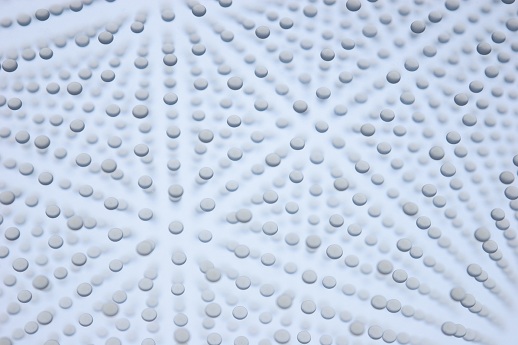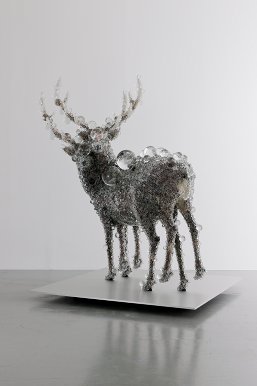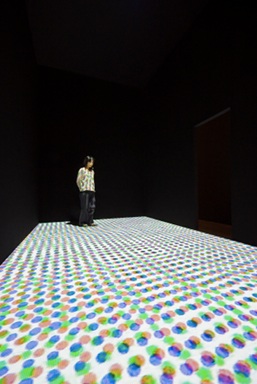Virtual Synthesis
Kohei Nawa’s works are a beautiful and well-balanced synthesis of art and science. Born in 1975 and a graduate of Kyoto University of the Arts, he is remarkably young considering his renowned position as one of Japan’s foremost contemporary artists. Now his first major solo exhibition at the Museum of Contemporary Art brings together established works along with new works.
Interestingly, the exhibition deliberately places no information beside the pieces and asks viewers to appreciate the works without titles and captions until the end of the exhibition when they can pick up a detailed map. This idea is appropriate for Nawa’s works as they draw on textures, materials and technology that viewers can engage with, guessing his methods and motives. At the entrance to the exhibition, you are greeted by a black spider-web ‘drawing’ that spreads across the wall, alluring in its metallic shimmer and detailed string-like patterns. When looked at closer, what appears to be an almost jewelry-like consistency reveals itself to be the plastic blobs of a glue gun. This is the type of simplicity in execution and elegance in form that is the most appealing part of Nawa’s art practice.

A room with stark lighting almost like that of a hospital becomes the setting for one of Nawa’s most impressive and mysterious works, ‘Prism’. Placed on the floor and against the walls are several boxes with random objects — a cactus plant, chair, baguette, etc. — that appear to be placed inside. Yet, due to the silvery surface of the box, the object is at once reflected and absorbed, duplicated or made invisible, turning the object into a hologram-like image. This symbolizes Nawa’s theme of ‘synthesis,’ in that he has essentially turned a banal object into an imprisoned virtual image through the use of a prism sheet — eternally fixed yet unable to be touched.
Again, in ‘Beads’, by covering the surface of the stuffed deer and other animals with countless transparent spheres he plays with the idea of objects that are there in physical form, yet unable to be reached. The deer also take on an unnerving element as Nawa overlaps other deer, creating a Siamese-twin effect. Another layer of complexity exists due to the fact that Nawa found these transparent sphere images and the deer through online auction sites, therefore questioning the origins of three-dimensionality in a virtual Internet world.
Works that show a similar exploration with doubling include ‘Polygon’; the gigantic figures that were created with two models offset just a little from each other as in the deer to show a symbiotic relationship. Nawa aims to show how as individuals in today’s society, our dependency on information and being connected to a network is imperative to our existence. Further along in the rooms that are transformed by colored lighting are more sculptures of a representational nature, made out of a foam-like clay that reminds you of the foam from residue. Though captivating in their various sizes and dimensions, you cannot help but feel they strayed from Nawa’s core ideas, of cells multiplying and infinite in their quantity and constantly changing, best depicted by works like ‘Drawing’ and ‘Glue’.


The repeated motif of the cell in its various forms provides pure synesthetic pleasure, especially when one comes to the last rooms, completely pitch black except for two white pools of silicone oil that when emitting light, rises then falls, the volume of bubbles aligned to a grid. As we sit closer to the liquid you begin to fall into a meditation, struck between the desire to touch the liquid and the satisfaction of the bubbling grid.
Finally, Nawa gives the opportunity to be a part of his artworks with ‘Dot Movie’, where the shadows of each person walking around creates an image layer of dots in various colours and sizes, breaking up and splitting. The interactive nature of the work is yet another equation of the ‘synthesis’ theme, where our form is contingent on the image-making and vice versa. Nawa is an artist that knows how to play on our innate sense of textures, and our all-consuming desire to understand and control our tactile physical world. His works contain an element of mystery, always leaving one part for us to question his methods and materials. Starting his practice with the primordial and simple ‘cell’, his synthesizing leads to complex and subtle results.
Mio Coxon
Mio Coxon



